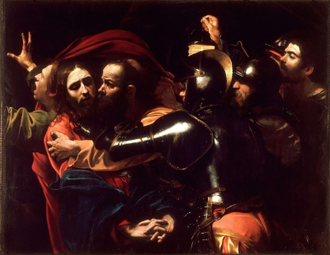Gospel in Art: Wednesday of Holy Week: Judas answered, 'Not I, Rabbi?'

The Taking of Christ, by Caravaggio, painted in 1602 © National Gallery of Ireland, Dublin
Source: Christian Art
Gospel of 16 April 2025
Matthew 26:14-25
At that time: One of the Twelve, whose name was Judas Iscariot, went to the chief priests and said, 'What will you give me if I deliver him over to you?' And they paid him thirty pieces of silver. And from that moment he sought an opportunity to betray Jesus.
Now on the first day of Unleavened Bread the disciples came to Jesus, saying, 'Where would you have us prepare for you to eat the Passover?' He said, 'Go into the city to a certain man and say to him, "The Teacher says, My time is at hand. I will keep the Passover at your house with my disciples." ' And the disciples did as Jesus had directed them, and they prepared the Passover.
When it was evening, he reclined at table with the Twelve. And as they were eating, he said, 'Truly, I say to you, one of you will betray me.' And they were very sorrowful and began to say to him one after another, 'Not I, Lord?' He answered, 'He who has dipped his hand in the dish with me will betray me. The Son of Man goes as it is written of him, but woe to that man by whom the Son of Man is betrayed! It would have been better for that man if he had not been born.' Judas, who would betray him, answered, 'Not I, Rabbi?' He said to him, 'You have said so.'
Reflection on the painting
Our reading today confronts us with a deeply painful truth: Judas Iscariot, one of Jesus' closest companions, plots to betray him. The wound inflicted on Christ did not come from a stranger, but from within his own inner circle... from someone who had walked with him, listened to him, and received so much from him.
The Gospel suggests that money may have played a part in Judas' decision, but surely the reality runs deeper. Perhaps it was jealousy, disillusionment, ambition-we cannot fully know. But what we do know is that this act of betrayal came not from outside the circle of trust, but from the very heart of it. Judas' story is not just about him though. It holds up a mirror to us all. Each time we fail to recognise Christ in others, each time we act with unkindness, indifference, or selfishness, we too participate in that betrayal. Lent invites us to ask: is there a Judas-like impulse in me? Where have I wounded the Body of Christ in my daily choices?
This theme is powerfully captured in Caravaggio's almost cinematic painting of The Taking of Christ. The scene is dramatic and intimate. Seven figures are caught in a frozen moment of betrayal. From left to right, we see Saint John, Jesus, Judas Iscariot, three soldiers, and a man holding a lantern, believed to be a self-portrait of Caravaggio himself. Judas has just kissed Jesus, the prearranged signal for the arrest. Jesus pulls back-not in anger, but in heartbreak. His face reflects the pain of betrayal, not with rage, but with wounded love.
To the left, John flees in terror, his red cloak billowing as a soldier reaches to grab him; a striking contrast to the chilling calm of Judas and the cold efficiency of the arresting soldiers. Yet the most striking element is not any single figure, but the shining, metal-clad arm of the soldier at the centre of the painting. Its brightness draws the eye, almost unnaturally so. It is believed Caravaggio intended this armoured reflection to act as a mirror, not just of light, but of conscience... a mirror for us all. It is as if the artist is asking us: Can you see yourself here? Are you a bystander? The betrayer? The one who flees?
This image and this Gospel challenge us not simply to condemn Judas, but to examine our own hearts and to return once more to Christ with humility, repentance, and love.
LINKS
Gospel in Art: https://christian.art/
Today's Reflection: https://christian.art/daily-gospel-reading/matthew-26-14-25-2025/ (with audio)


















